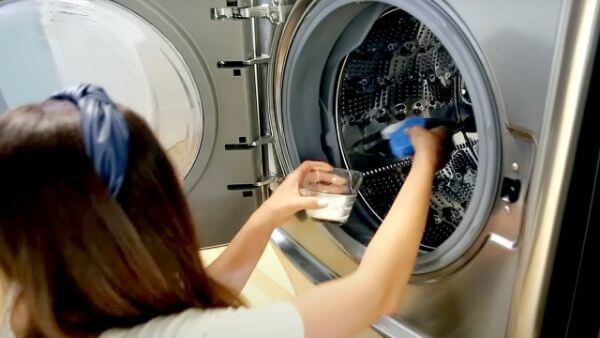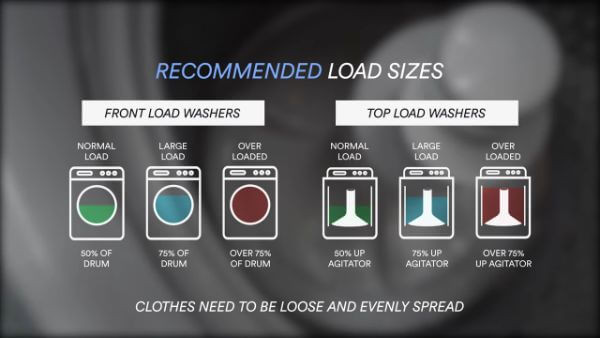Nobody wants an issue with your appliance. Here we’re covering washers and how to keep them maintained so that you don’t have those pricey issues down the road.
We’re covering washers here and giving five tips, but there’s different washer platforms. There’s top loads with agitators, without agitators, and then there’s front load washers. Each one requires separate maintenance tips and we’re going to go over a handful of those that apply to each type of washer.
Table of Contents
Do Not Overload Your Washer
Maintenance tip number one is do not overload your washer.
Most of us, and myself included, many times want to get laundry just done as fast as you can so we grab the pile of clothes, load it in, because we don’t want to do two or three loads.
So we stuff it full. That is a no-no!
Overloading your washer can cause a couple things.
One, your clothes won’t get as clean. That is a major issue. We all want our clothes to be clean. Two, it increases the stress on your washer, on the motor, on the belts that are within your washer.
If it’s unbalanced, your washer is going to move and jump during the wash cycles, which are going to put added stress on the components, causing the washer not to last as long and you may have more maintenance issues into the future.
Make sure you check what the capacity size is of your washer. It’s pretty easy to find. You might have to look up the model number to do that, but large capacity washers are typically those washers over 4 cubic feet capacity.
A lot of people wonder can I put a king comforter inside of a washer. On these large capacity washers, you can, but follow the manufacturer’s suggested capacity sizes.
When you’re filling up a washer, the top load washers with agitators are different than front load washers. However, manufacturers typically recommend you don’t overload a washer more than three quarters full.
If you go more than that, they considered overloading. You may have some of these issues down the road.
Correct Detergent & Amount
Maintenance tip number two deals with your detergent.
Laundry detergent is very important as you use your washer. This can make your clothes smell, it can make your clothes clean, and it could also damage your washer if you’re not using the right types of detergents.
How do you know what detergent your washer uses?
Most washers, if you’re buying a brand new washer, require HE – high efficiency laundry detergent. How do you know if your machine needs that? Most machines will have the label that tells you that you must have high efficiency detergent.
When you’re buying your detergent, if boxes or bottles have that HE symbol, it is high efficiency detergent.
Why is that important?
Because it’s a concentrate of soap. If you don’t use a high efficiency soap, you’re going to end up using too much soap, and during the wash cycle there’s going to be too much soap left into your clothes. There’ll be too much suds that build up during the wash cycle, which flows into the components of the washer, causing you maintenance issues and headaches in the future.
Most of us have seen a Tide bottle liquid detergent with the cup on top. It has little marks of 1, 2, 3, 4, 5.
Manufacturers recommend that as you’re doing a load in the washer, if it’s an average load, filled halfway up, use level one or level two. It’s very minimal. A lot of us like to just grab the cup, fill it all the way up and use it. That’s using too much soap.
If you have a fuller load, as we talked before, a three-quarter load, all the way full, you may want to use a three or four. You just don’t want to use too much soap. That can do a lot more damage than if you use not enough soap.
Clean Your Washer

Number three maintenance tip is clean your washer. The areas you want to clean are the dispensers as well as inside of the drum.
With top loads you want to clean around the agitator, tight spots along the lid. With front loads you want to clean not only in the dispensers, but also on the rubber seals.
If you’re looking for a washer, some of you may be concerned about smells of front loads.
Historically when front loads first came out, there was many smells that got associated with front loads because of build up of the mildew.
It’s very important to make sure you’re cleaning your washer on a consistent basis so the mildew does not build up and affect the smell as well as the components of your washer,
Leave The Door Open
Tip number four is leave the door open.
Why we say that’s a good maintenance tip? Because of that mildew or the moisture that is built up during a wash cycle. If you leave the door shut after a wash cycle, then that’s when the mildew will begin to grow and the smells may form after that.
Some washers do come with some added venting capabilities where they don’t require to leave the door open.
None of the manufacturers say they require you to leave the door open, but that’s a good tip.
To keep the inside of our washer clean, to get rid of any mildew or chances of it, as you’re finished with your laundry load, you want to transfer that laundry over to your dryer as soon as possible.
If you leave your clothes sitting in the washer, that builds up the chance for the added smells into your clothes, which eliminates the whole reason you’re washing it clothes to begin with.
But transfer it as soon as you can because if you leave it in your washer there’s that chance of added mildew buildup in not only your washer but also transferring that smell into your clothing.
Check The Hoses
Maintenance tip number five is making sure that you check the hoses and the different connections on the back of your washer.
The reasons why you should check this is if you find any leaks or loose hoses it may eliminate the chance of a flood or of a leak that may damage your flooring into the future.
How do you do that?
It’s very simple. On the back of your washer, there are connections. There’s a hot water and a cold water connection. You want to check those, make sure those are tight. Also it runs into the water connector into your house. Make sure those are tight.
And then you also want to check the drain hose as well. If it has come out, it has a chance of coming all the way out, so when the washer drains water gets all over, so you want to make sure that’s secure inside the drain hole.
It’s recommended that you check these hoses and these fittings at least once a month to see if you find cracks or other potential issues that will cause maintenance issues down the road.
I personally recommend that you purchase stainless steel hoses. This will cause them to last a lot longer than rubber hoses and less likely to have leaks or cracks and cause flooding issues into the future.
We hope you found these five maintenance tips useful for your washer. Hopefully one of these tips are going to help you keep your washer in even better shape.
All Natural Laundry Detergent Sheets

